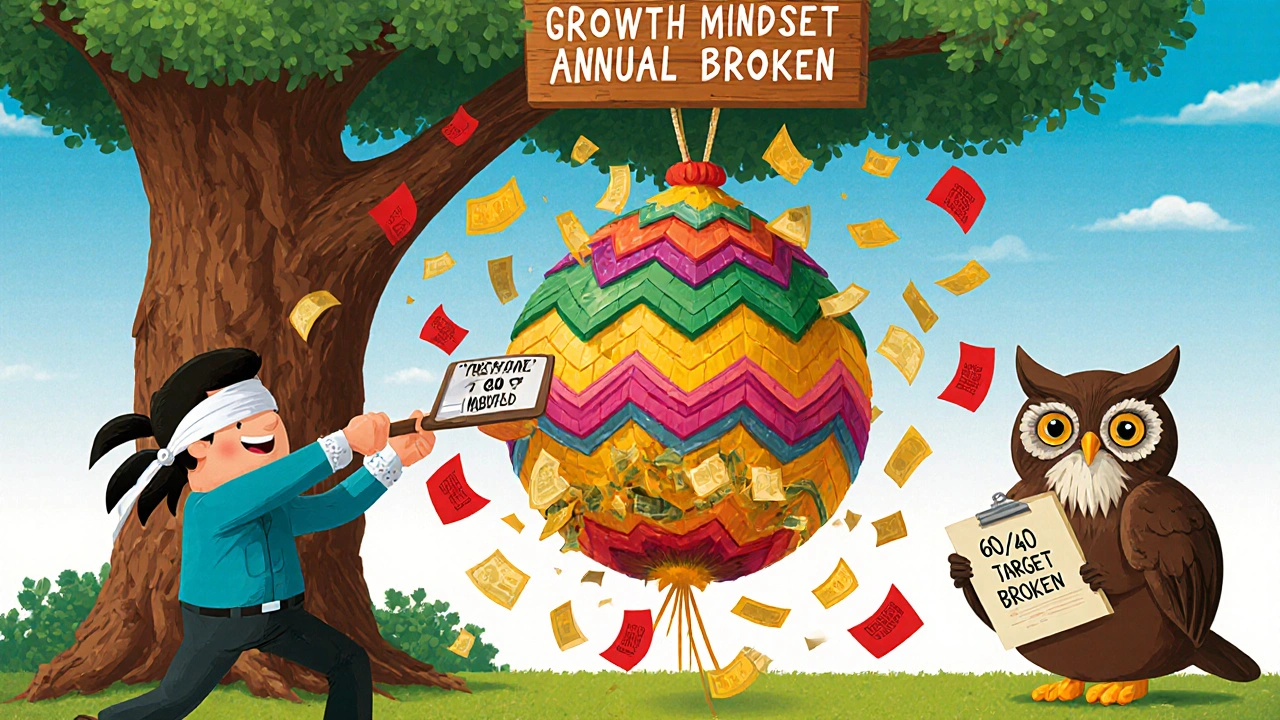Portfolio Rebalancing Calculator
Current Portfolio Analysis
Enter your current portfolio values and target allocations to identify rebalancing needs. Based on the 5% deviation threshold recommended in the article.

Enter your current portfolio values and target allocations to identify rebalancing needs. Based on the 5% deviation threshold recommended in the article.
Most people think their portfolio is fine if it’s growing. But growth alone doesn’t mean it’s working the way it should. A portfolio that started with 60% stocks and 40% bonds might now be 75% stocks because the market surged last year. That’s not diversification-that’s risk. Without a systematic annual assessment, you’re flying blind. You might be holding too much in one asset, missing tax opportunities, or ignoring fees that slowly eat away at returns. The goal isn’t just to check numbers-it’s to make sure your portfolio still matches your goals, your timeline, and your tolerance for risk.
A true annual portfolio review isn’t a quick glance at your balance. It’s a process with clear steps. The CFA Institute and Morningstar both agree: start with the big picture. First, compare your current asset allocation to your target. If your stocks are more than 5% above or below your target, it’s time to rebalance. That’s not a suggestion-it’s a rule of thumb backed by decades of data. Next, look at performance attribution. Don’t just ask, “Did I make money?” Ask, “Why?” Was it one stock? A sector? Or just the market going up? Holding a single tech stock that doubled last year might feel like skill, but it’s often just luck. A proper review separates luck from strategy.
Rebalancing isn’t exciting. It doesn’t make headlines. But over 30 years, it can add 1-2% annually to your returns. How? By forcing you to sell high and buy low-without emotion. When tech stocks surge, you sell some. When bonds dip, you buy more. That’s the opposite of what most investors do. Morningstar’s 2024 guide shows that investors who rebalance annually after a 5% deviation outperformed those who didn’t by an average of 0.8% per year. And that compounds. A $500,000 portfolio gaining 0.8% extra per year adds $120,000 over 20 years. The trick? Do it once a year, not every quarter. Too frequent rebalancing eats into returns with fees and taxes. Too infrequent, and you’re exposed to volatility you didn’t sign up for.

Here’s where most annual reviews fail. People focus on returns but ignore three silent killers: taxes, fees, and cash drag. Did you realize you sold a stock in a taxable account and triggered a $3,000 capital gain? Did you pay 1.2% in fees on a passive index fund that charges 0.05% elsewhere? Are you holding $20,000 in cash because you’re waiting for a “better time” to invest? That cash is losing value to inflation. A proper review checks all three. Use the SEC’s 2024 Portfolio Review Checklist for RIAs as a template. Look at your expense ratios. Run a tax-loss harvesting scan. And ask: Is my emergency fund still in a savings account earning 0.1%? If it’s more than six months of expenses, consider a short-term bond fund or high-yield savings account with FDIC insurance.
You don’t need fancy software. But you do need consistency. Free tools like Personal Capital or Vanguard’s Portfolio Watch can track allocations and send alerts when you’re off-target. But don’t rely on them for tax advice or deep performance attribution. For that, you need spreadsheets or a financial advisor who uses holdings-based attribution. Avoid tools that only show total returns. They hide the real story. For example, your portfolio might have returned 12% last year-but if 10% came from one stock you bought on a tip, you’re not diversified. You’re exposed. The Gartner TIME model (Tolerate, Invest, Migrate, Eliminate) is used in IT portfolios, but the same logic applies to investments: which holdings are still serving you? Which are just taking up space? Cut the dead weight.
One Reddit user, InvestorJourney89, did a full review in January 2024 and found his tech stock allocation had jumped to 32%-way above his 15% target. He sold $45,000 in excess and bought bonds and international stocks. His portfolio returned 3.2% better than the S&P 500 over the next year. Another user, PortfolioStruggles, skipped tax planning and ended up paying $1,200 more in capital gains because he didn’t realize he could have offset gains with losses from underperforming funds. In enterprise settings, a company using SAP’s 6R Framework for IT systems saved $2.3 million by retiring outdated software-but took six months to clean their data first. The lesson? Preparation matters. Clean data, clear targets, and discipline beat fancy tools every time.
BlackRock shifted from annual to bi-annual reviews during 2020-2022 because markets moved too fast. If you’re nearing retirement, or if your life has changed (new job, divorce, inheritance), don’t wait. A major life event is a trigger for a review-even if it’s not December. Similarly, if interest rates spike, inflation surges, or a new regulation hits (like the SEC’s 2024 proposed rules), you need to reassess. The CFA Institute’s 2025 guidelines now require ESG factors to be part of the review. If you’re invested in fossil fuels or companies with poor governance, you might be taking on unseen risk. Your annual review should now include a quick ESG screen: are your holdings aligned with your values and long-term risk profile?
Nobel laureate Eugene Fama was right: markets are efficient. No one can consistently time them. But you can control your portfolio’s structure. A systematic annual review is the most reliable way to stay on track. It removes emotion, enforces discipline, and protects you from the silent erosion of fees, taxes, and drift. You don’t need to predict the next recession. You just need to know your numbers, stick to your plan, and adjust when you’re off course. That’s how real wealth is built-not by chasing hot stocks, but by quietly, consistently, doing the work others skip.
Laura W
October 30, 2025 AT 11:58Yo, this post is fire. I literally just did my annual review last week and caught that my crypto bag had ballooned to 22% of my portfolio-total nightmare fuel. Sold half, dumped it into TIPS and international small caps. Feels like I just did a detox for my finances. Also, who knew holding $15k in cash earning 0.1% was basically giving inflation a vacation? Thanks for the wake-up call.
Also, PS: if you’re using Personal Capital, turn on the fee analyzer. It screamed at me about a 0.8% expense ratio on a fund that should’ve been 0.07%. Total facepalm moment.
Graeme C
November 1, 2025 AT 05:48Let me be blunt: if you’re not rebalancing annually after a 5% deviation, you’re not investing-you’re gambling with a spreadsheet. The CFA Institute isn’t some vague think tank; it’s the institutional gold standard. And yet, 78% of retail investors still rely on ‘feelings’ and ‘market vibes.’
That $120,000 compound gain over 20 years? That’s not magic. That’s discipline. That’s refusing to let your emotions hijack your asset allocation. And yes, I’ve seen the data: those who rebalance outperform by 0.8% annually. Not ‘sometimes.’ Not ‘in bull markets.’ Every. Single. Year.
Also, tax-loss harvesting isn’t optional. It’s the silent tax cut you’re leaving on the table. If you’re not scanning for losses before December 15, you’re financially negligent.
Julia Czinna
November 2, 2025 AT 17:01I appreciate how practical this is. I used to think portfolio reviews were for hedge fund managers with Bloomberg terminals. But breaking it down into eight steps? That’s doable.
I started last year with a simple Google Sheet-just assets, target %, current %, and expense ratios. Took me two hours. Now I do it every January like brushing my teeth. No drama. No panic. Just math.
Also, the ESG screen bit? I didn’t realize my ‘diversified’ fund had exposure to coal companies. Found out via Morningstar’s sustainability rating. Switched to a low-carbon index. Felt better about my money.
Astha Mishra
November 4, 2025 AT 08:24It is truly fascinating how the human psyche, in its infinite complexity, often conflates the notion of growth with that of wisdom, when in reality, the silent, unglamorous act of rebalancing-this quiet, almost meditative discipline of selling high and buying low-is the truest form of financial mindfulness.
One cannot help but reflect upon the metaphysical implications of holding cash in a low-yield account while inflation, that invisible thief, steadily erodes the value of one’s labor. Is not money, in its essence, a social contract? And when we neglect to steward it with intention, do we not betray not only our future selves but the very principles of rational stewardship that underpin civilized society?
And yet, the tools! Oh, the tools! Personal Capital, Vanguard Watch-they are but mirrors, reflecting our financial state without the moral clarity to guide us. We require not merely data, but a philosophical framework to interpret it. The Gartner TIME model, though born of IT, resonates profoundly: tolerate what serves, invest in what aligns, migrate from what lingers, eliminate what haunts.
Perhaps the most radical act in modern finance is not speculation, but consistency. To show up, year after year, with a spreadsheet and a calm heart, is to defy the chaos of the market-and of life itself.
Kenny McMiller
November 5, 2025 AT 11:41